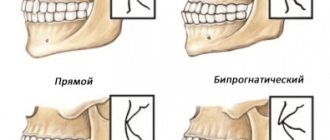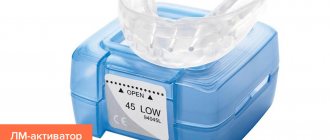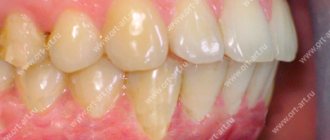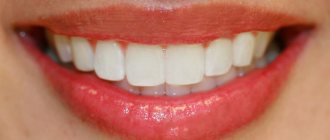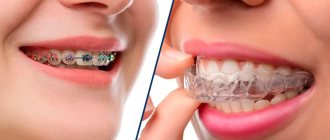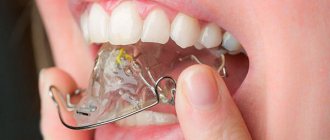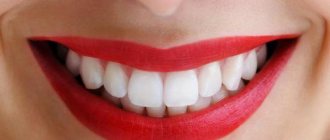Crossbite is a disorder in which several teeth in the lower jaw overlap parts of the upper jaw and vice versa. Along with reverse incisor overlap, it is a common pathology that begins at the time of intrauterine development of the fetus, or develops as a result of childhood habits. Note that if at least one tooth in a row violates the overlap, it will be a crossbite and will require treatment to prevent complications.
This disorder causes severe physical discomfort in patients due to developing facial asymmetry. It can be detected visually, by external examination or by smiling, which also causes a number of problems when communicating. However, it is possible to correct a bite of any complexity - you need to go to the clinic for an appointment with an orthodontist. Orthodontic systems will help return teeth to their original position, correct your smile and remove any discomfort in just a few years of treatment.
Causes
Cross occlusion, like many malocclusions, begins in early childhood during the development of permanent teeth. The reasons can be factors that depend on the person (improper or poor oral hygiene, physical trauma, the formation of bad habits since childhood), as well as health problems or congenital pathologies (jaw structure, impaired development of the dentition, lack of a number of substances and vitamins).
The most common reasons:
- improper development of the jaws. This is affected both by a lack of calcium, which is necessary for the formation of teeth and strengthening the jaw, and by a delay in the appearance of permanent dentition. Often, normal development is disrupted by congenital and hereditary anomalies, otolaryngological diseases suffered in early childhood. As a result, the resulting problems progress with age, gradually distorting the dentition;
- improper closure of baby teeth. During normal development, baby teeth wear down evenly, thereby closing together. Disorders appear when the wear of the fangs is lower than that of the rest of the dentition - they begin to slip, displacing the entire jaw. Subsequently, permanent teeth will initially grow incorrectly;
- loss of baby teeth. As is clear from the example above, normal development of primary teeth is necessary for jaw development and preparation for permanent dentition. Caries, physical trauma or early loss displace permanent teeth, which disrupt future closure;
- negative habits. Placing objects in the mouth, shifting the jaw to the side - these initially insignificant impacts, when constantly repeated, lead to growth deviations and further malocclusions.
In an adult, healthy person, the risk of developing cross-occlusion is much lower, since the jaw system is already formed without anomalies. The cause may be external factors, such as poor-quality prosthetics with crowns or veneers, as well as facial injuries that lead to tooth loss or jaw injury. It is important to constantly maintain the correct bite, and if it is violated, to correct the deviations in a timely manner.
Price
The tables show approximate prices in Moscow for crossbite correction in children.
| Name of service | Price in rubles |
| Correction of occlusion anomalies with aligners | from 180000 |
| Selective teeth grinding | from 477 |
| Correction using the Frenkel apparatus | from 20000 |
| Correction of the defect using surgical methods | from 200000 |
| Correction using the Andresen-Goipl activator | from 18000 |
| Braces | from 63000 |
| Correction using Klammt activator | from 16000 |
Correction of cross-occlusion should begin as early as possible. The defect is difficult to treat conservatively in children during the period of mixed dentition, and in adults it is not successful.
Kinds
Facial asymmetry is a common symptom for any type of crossbite. However, even with its presence, such occlusion has several forms. They depend on the position of the jaw and teeth relative to the normal position. In particular, the disorder can begin in the anterior region - then the jaw noticeably protrudes forward, protruding, even if the mouth is closed. Disorders are also common in the lateral regions, shifting the jaw to the side depending on the curvature. Most often, orthodontists diagnose a “scissor” bite, in which the upper row of teeth completely overlaps the lower one, forming a picture typical for this type of occlusion
Buccal and lingual occlusion are considered from the point of view of the position of the dental row - which of the jaws covers the other in a normal position. The first is associated with excessive development of the lower jaw, due to which it overlaps the upper one. The lingual one has the same signs, but exactly the opposite - the upper jaw covers the entire lower jaw.
Orthodontists also study the distribution of occlusion. The violation can happen to one or two teeth, or affect the entire jaw row. Moreover, the first violation threatens to develop into a more extensive stage if treatment is not started on time.
Prevention
Correcting this type of disocclusion is expensive and time consuming. Success depends on the age at which correction of the defect begins and its complexity. If you follow doctors' recommendations, you can correct it.
Activities include:
- prevention of pregnancy complications;
- stopping bad habits in children;
- timely treatment of caries;
- prosthetics for early loss of teeth;
- prevention of rickets.
It is necessary to regularly visit the orthodontist to promptly resolve issues regarding the correction of occlusal defects.
Signs
Crossbite can be determined by external signs, without special instruments. Depending on the size of the lesion, several teeth or the entire dentition of the lower jaw will overlap the corresponding upper ones, as if intersecting. In a normal position, they should close tightly.
Also a common symptom of occlusion distortion is facial asymmetry, which is noticeable even with the mouth closed. Due to the incorrect position, the jaw moves to the side along with the chin, which is noticeable to the naked eye. Note that noticeable asymmetry does not appear in all cases, or may be the cause of other disorders that are not necessarily related to teeth.
However, correcting a crossbite is necessary because it causes physical discomfort - the teeth cling, wear off each other, and cause multiple problems. In general, improper jaw position negatively affects the entire system. Joints develop unevenly, which leads to their dysfunction, bones become bent, which in the long term can only be corrected by surgery. Moreover, the consequences can overtake the patient even after a course of treatment, as a result of which orthodontists prescribe additional medications or training.
The danger of a malocclusion is that the patient does not always notice it. The disorder develops over time, the sensations adapt to it, and as a result, the patient notices the consequences of the anomaly too late. In the case of children, this is especially important, so parents must be attentive. It is necessary to stop negative habits, and at the first signs of occlusion distortion, contact an orthodontist for a clear diagnosis.
What kind of pathology is this
Crossbite in children is manifested by the crossing of dental lines when the jaws are fully closed. Characterized by a lack of correspondence between the shape and size of the dental units in the transverse plane. The main manifestation of this defect is the displacement of the jaws relative to each other, as a result of which asymmetry of the patient’s face is necessarily formed. It is considered the most severe of this class of disorders. A similar anomaly is recorded in 3% of people in the structure of all pathologies of occlusion (closing), and therefore is considered quite rare.
Stages of Deviation
Cross-occlusion develops differently depending on the size of the problem. The most common dentoalveolar form is the initial one, in which the problem begins directly with the teeth. An uneven row due to developmental anomalies causes discomfort, which is why the jaw is subsequently fixed incorrectly in adulthood. If the dental alveolar form is not corrected in time, it will develop into a more serious one.
The skeletal one distorts the position at the level of bone tissue. It develops as a consequence of the dentoalveolar form, or becomes the initial cause of crossbite due to a violation of the formation of the jaw. Note that it is more difficult to treat than the first one - surgery is often required to correct such deep disorders. The dentoalveolar one is corrected with the help of veneers or aligners.
Need some advice?
Enter your phone number and we will give you a free consultation
Make an appointment
*By making an appointment you consent to the processing of your data
Treatment of dental abnormalities in adults
When working with adults, the orthodontist uses combined techniques, including orthognathic surgery techniques. In most cases, it is possible to obtain the desired results in a conservative way - with the help of aligners and braces.
If it is not possible to restore the normal position of the teeth due to their crowding, a decision may be made to remove (depulpate) specific units. Most often, surgeons remove eights or fours.
When the jaw bone is crooked, an osteotomy is performed. This is a surgical intervention designed to correct the resulting bone deformation. Therapy is carried out under general anesthesia. It is traumatic, so during the rehabilitation period the patient has to stay in the hospital. After healing, you must wear mouthguards or braces.
What are the differences between bite forms?
It is possible to distinguish what type of malocclusion is manifested in a patient visually. If the central line of the dentition coincides, then everything is in order with the facial skeleton. Since the jaw slides to the wrong position only when it is closed, the problem is at the level of the teeth, and it is quite easy to fix it - a long course of treatment with aligners is enough for this.
If the line does not match, then this indicates improper formation of the jaw. Developed asymmetry, atypical proportions of the chin, all this is a consequence of the skeletal form of the disorder. Only surgical intervention or a combined effect will restore the correct shape of the jaw.
How to avoid
The bite is formed while the body is still developing. As a result, the child’s different habits become fixed in his development, which is why violations occur. For example, if a child specifically changes the position of the jaw out of interest or experiment, causing it to become incorrect for a long time, supports it with his hand, or often touches only the teeth that are emerging, all this can provoke their deviation. It is worth checking the child’s sleeping place. Incorrect pillow height contributes to the curvature of the spine and jaw displacement.
You can notice a displacement of a child’s jaw without professional skills. In this case, it is worth showing him to an orthodontist to correct the bite. The doctor will carefully examine the anomaly, find the causes of the disorder and give a number of recommendations - habit correction and exercise. In childhood, the problem is corrected quickly if the child follows the recommendations, but in adults it is much more difficult to treat.
Manifestation of anomaly
A characteristic symptom of crossbite is the specific position of the teeth described above. For this reason, a number of facial and oral symptoms may appear, namely:
- smile disorder;
- the corners of the lips are located at different heights;
- chin displacement;
- violation of the movement of the lower jaw;
- dysfunction of the jaw joints (crunching and clicking when opening the mouth);
- dental diseases (increased abrasion);
- gum disease;
- pain in facial muscles;
- wedge-shaped defect;
- irritation of the cheek mucosa (due to frequent biting).
Consequences
Crossbite in permanent teeth causes many consequences with long-term exposure. Therefore, when detected, it is important to begin correction. For example, the dentoalveolar form subsequently turns into a skeletal form, which can no longer be corrected by orthodontic mechanisms - only by surgical intervention to correct the facial skeleton.
An incorrect bite creates an uneven load on the joints, as a result of which they begin to develop with poor posture. This distorts the growth of permanent teeth, contributes to their abrasion on other surfaces, which leads to caries and destruction of enamel. Teeth clinging to each other lead to chipping, development of cracks and wedge-shaped defects, contribute to gum problems and injure the mucous membranes.
Please note that the symptoms will not necessarily manifest themselves in full, since their appearance is influenced by various factors. However, if crossbite treatment is not started, improper load on the teeth will significantly increase the risk of abrasion and, as a result, destruction. In addition, constant joint pain will appear as a result of dysfunction and uneven development of the joints.
Treatment
Modern orthodontics can correct malocclusion of any complexity - from several teeth to a complete correction of the jaw. For this, various influences are used. For mild forms of curvature, long-term treatment with orthodontic mechanisms is sufficient, while severe problems will have to be corrected during surgery.
As we indicated above, the shape of the jaw is formed in childhood, so treatment should begin in the early stages. Only an orthodontist can make a final diagnosis and recommendations. If a child has occlusion pathologies, self-medication can cause complications.
Sign up for free 3D modeling of your future smile!
Make an appointment
*By making an appointment you consent to the processing of your data
Treatment of children's bite takes place after examination. The images taken and their analysis help formulate a treatment plan based on the current form of the disorder. As a rule, braces are prescribed for correction, but they are inferior to aligners. These medical mouth guards work on a similar principle - they create constant micropressure on the teeth, gradually aligning them in the desired direction. However, unlike braces and plates, aligners are almost invisible and can be easily removed for cleaning and oral hygiene, so it will be easier for the child to follow the recommendations regarding them.
Orthodontics distinguishes two methods of how to treat crossbite:
- orthodontic treatment. As in the case of children, correction is carried out by orthodontic mechanisms. A popular method is aligners, which combine convenience and effectiveness. The standard course lasts from one and a half to two and a half years, depending on the degree of correction;
- surgical intervention. Often combined with the installation of braces, this method allows you to correct violations in the development of jaw bone tissue. Surgery is used as a last resort when the jaw itself requires correction.
In some cases, surgery may be contraindicated due to complications. At the same time, aligners cannot completely correct the dentition due to their complexity. Then an incomplete correction is carried out under the supervision of an orthodontist to avoid relapse in the future.
How to correct children's bite?
After diagnosis, a specialist will suggest the correct method to parents.
- Babies need to be bottle-fed with the correct nipple and ensure that they do not sleep in the same position.
- Older children should chew solid foods, while more often loading the deformed side of the dentition.
- If there is a one-sided curvature of the cusps of individual teeth, the doctor can lightly grind them to remove them from the pathological bite.
- It is imperative to monitor how the child swallows and breathes.
- Prematurely lost milk teeth must be promptly replaced with special children's dentures, to which children very quickly get used to.
If there is a need to expand the jaw, special expanders are used, and a pressure bandage that separates the bite helps slow down the development. More serious defects are corrected with specialized structures - a function regulator, an activator, a plate and mouthguards, and at 10-12 years of age, after the primary dentition has changed to a permanent one, braces are used.
Complications during treatment
Cross occlusion leads to jaw development problems that may persist after treatment. Most often, joint dysfunction occurs because the load on it changes due to a change in the position of the teeth. It can be expressed both in poor jaw function and in periodic pain.
Complications are corrected by consistent exercises prescribed by the orthodontist, along with painkillers. Today, orthodontic methods make it possible to predict possible complications and eliminate them in a short time, preventing the progression of problems.
Diagnostics
To make a diagnosis, the orthodontist examines the patient's face and oral cavity. He examines the size, shape of the jaws, and the relationship of the dental lines. The doctor listens in detail to the patient’s complaints and analyzes the information received. Based on this, he makes a preliminary diagnosis.
The following are prescribed as additional studies to make a final diagnosis:
- teleradiography of the skull;
- orthopantomography;
- study of front and profile photography;
- produce diagnostic models of the jaw and examine them;
- occludogram;
- radiography of the maxillary joint;
- rheography;
- electromyography of the face.
The doctor performs functional tests, studies the functions of the jaw and maxillary joint. For a comprehensive diagnosis of the disease and assessment of disorders, specialized specialists (neurologist, speech therapist, otolaryngologist, pediatrician) are involved.
Do you want to correct your crossbite? We are waiting for you at the PROPRICUS clinic!
- The leading expert of the clinic, Nana Gezalova, is doctor No. 1 in the Invisalign rating. This is a talented orthodontist with 15 years of experience and extensive experience working with Invisalign aligners. She personally trains the clinic’s orthodontists and strictly controls the quality of treatment for each patient.
- We never change the cost of treatment after signing the contract. The price of treatment does not increase, even if the dollar exchange rate has changed.
- The clinic’s specialists continuously improve their knowledge and skills, participate in international conferences, and communicate with foreign colleagues.
- We use advanced equipment and regularly update our technical fleet.
- We don’t just straighten teeth, but work comprehensively to ensure healthy jaw joints, correct bite and high aesthetics.
